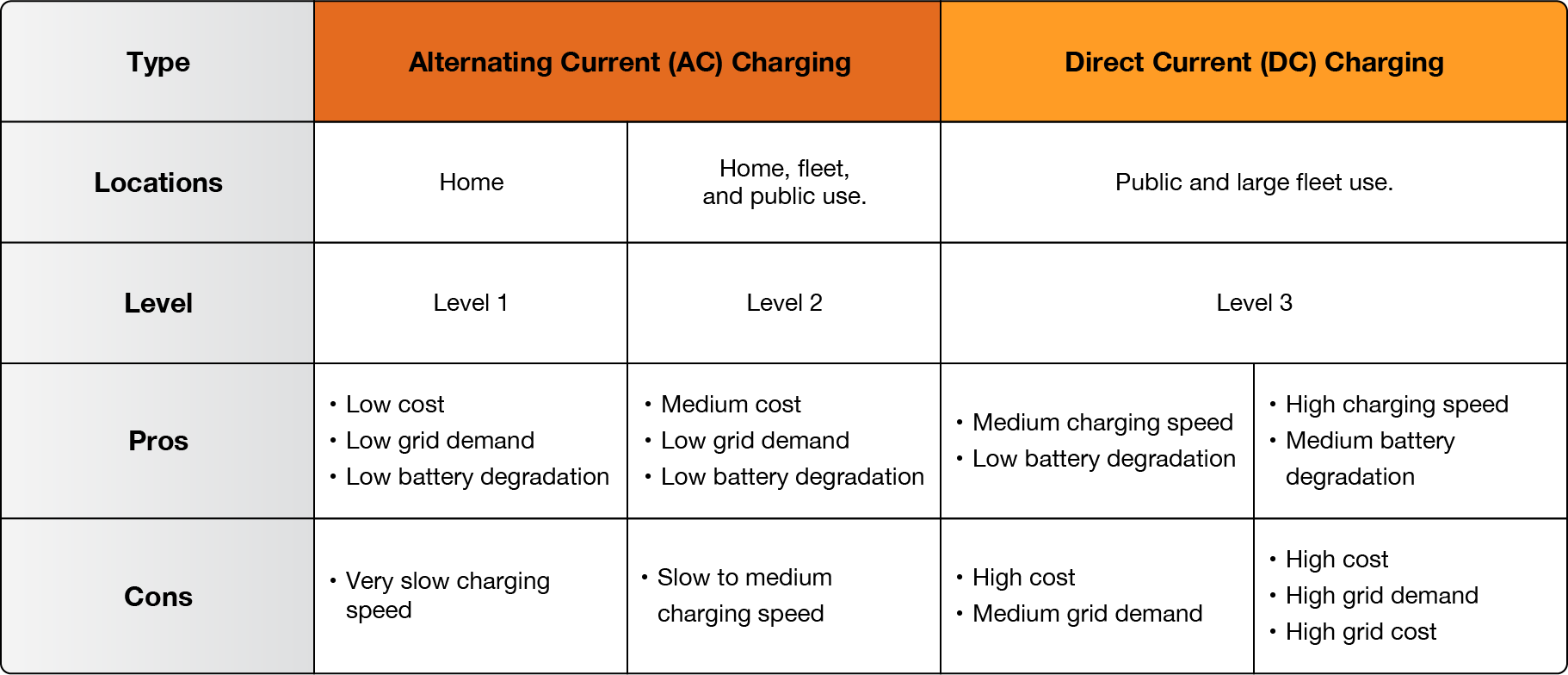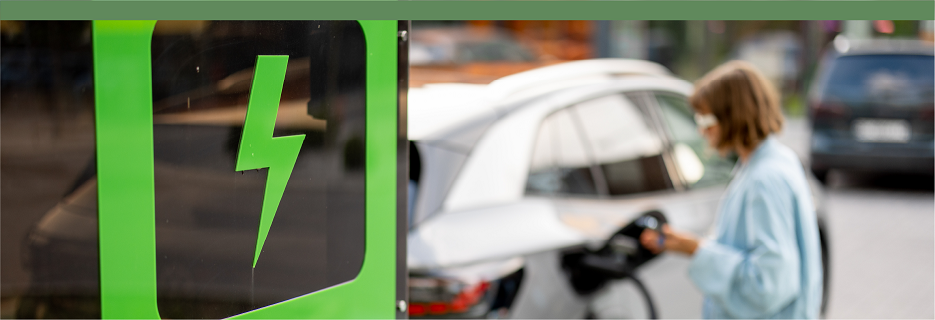Go Green With an Electric Vehicle

You’ve probably seen electric vehicles (EVs) zipping by on the highway or plugged into a local charging station. This greener alternative is fueled by electricity, creating a cleaner, more cost-effective drive. With quiet acceleration, less maintenance and better day-to-day affordability due to shrunken fuel costs, it’s no wonder so many drivers are switching to electrical models — the EV surge is just getting started.
Let’s make the most of every mile and work to reduce your carbon footprint. We’ve paired need-to-know information with the right resources to start your journey.
CLICK TO Join our ev community
How It Works
Ready to buy or considering a future purchase? Here’s what you need to know about owning and operating an EV.
EV Technology
Like gasoline-fueled cars, not all EVs are created equal — each is powered a little differently.
There are two distinct types on the market, so it’s worthwhile to understand the different driving range, energy usage and charging
options each offers.
- All-electric vehicles run solely on battery power.
- Plug-in extended-range hybrid vehicles (PHEV) generate energy from a battery. An internal combustion engine is used to extend the range of the vehicle, typically by recharging the battery.
Types of Chargers

Level 1 Charger
Residential
120 volt (standard outlet)
Approximate Charge Time:
Up to 40 miles in 10-12 hours
Charge Cost:
$3.39
Perfect For:
Daily travel, workplace
and overnight charging.

Level 2 Charger
Residential & Commercial
240 volt (dryer outlet)
Approximate Charge Time:
4-8 hours from empty to fully charged
Charge Cost:
$3.39 (Residential)
$5.25 (Commercial)
Perfect For:
Faster, convenient charges
on-the-go and for longer drives.

Level 3 DC Fast Charger
Commercial
Public Charging
Approximate Charge Time:
0 to 80% in 30-40 minutes
Charge Cost:
$4.80
Perfect For:
Rapid charging for any driving range,
but best for long distances.
Chart updated June 2024
Please note: Figures provided are estimates based on best available data. Each EV’s charge rate depends on a number of factors, including make, model, charger type, weather conditions and battery. Charge times/rates depend on the battery level, charger level, and time of day.
Types of EV Charging


Smart Charging Tips
SMART CHARGING
Schedule your EV to start charging after 9 p.m. Off-peak charging helps delay grid upgrades (and often you’ll be utilizing renewable wind energy)
OPTIMIZE CHARGING LEVELS (20-80 RULE)
Keep your battery between 20-80% charged
CHARGING FREQUENCY
Don't charge daily unless necessary
Average person drives 39 per day - charge every 2-3 days
CHARGING ENVIRONMENT
Avoid extreme hot or cold temperatures
Precondition your battery before charging
QUICK CHARGING
Limit Level 3 charging— especially in extreme temps— as it can accelerate battery degradation over time
REGENERATIVE BRAKING
Maximizes battery range & improves brake life
OTHER CONSIDERATIONS
Check your charger equipment regularly for signs of damage or wear
Choose the right charger - compatibility is key
Don't block access - when your done charging, move your vehicle
Stay up to date with software and firmware updates
Give your battery a break after long drives before recharging
Public Charging Stations
To ensure a smooth ride free of interruptions, we’ve worked with community partners to install several public charging stations throughout the Omaha metropolitan area and across the state — with more on the way.
Look at our map and click the links below for directions to the closest OPPD charging station. You can even extend your search to nearby cities for on-the-go travel charging.
Plus, we’ve identified some of our favorite fast-charge sites at the following locations:
Frequently Asked Questions
Can I charge my EV at home?
Yes, most vehicles can charge on one of two different levels at your home. All you have to do is get the charger installed by a licensed electrician. To learn more about the various types of charging, we’ve outlined the levels above.
When should I charge my EV at home?
The best time to charge a vehicle is at night or on weekends during off-peak hours, such as after 9 p.m. when energy demand and costs are lowest. Charging within this window ensures the least impact to the electrical grid.
How far can I drive an electric vehicle before having to charge?
You’ll be more than covered on your day-to-day drives. Under normal driving conditions, most EVs can travel between 200 and 300 miles on a full charge. For longer journeys or road trips, you’ll find many public charging stations across the country. Plus, as newer models hit the market, the charge range is only expected to increase.
The average American only drives 31 miles a day, so most EVs should meet your regular needs. For longer trips, there are public charging stations located across the country. Use the PlugShare app or any other EV charger mapping tool (available through the Apple Store or Google Play) to locate charging stations and plan accordingly.
How does cold and hot weather impact EV car batteries?
Extreme hot or cold temperatures could possibly cause your EV to lose range up to 50%. That means, if your engine normally gets 250 miles on a full charge, in extreme weather, you might only get 125 miles. Don’t want to worry about the weather? In extreme cold or heat, be mindful of your car’s charge. Leave significant margin, charge more frequently and be sure to precondition your battery before charging.
Additionally, many EV manufacturers have apps with features that let you schedule departure times, so your vehicle can be preconditioned for travel while still connected to a charging source.
How will my energy bill be affected by having an EV?
The time of year, length and strength of your charge all play a role in energy bills. The average cost of charging a plug-in vehicle at home is about half the cost of filling a tank of gasoline, according to the Department of Energy (DOE). Check out the DOE’s Vehicle Cost Calculator for an estimate of how much you can save overall.
How much does it cost to charge an EV vs. fueling a traditional car with gasoline?
The actual number will depend on the make and model of your car, your location, the weather and other varied factors. Here is an estimate, using average numbers.
OPPD costs for at-home EV charging are approximately $35* on your monthly utility bill. Monthly fuel costs for traditional combustion engine cars are about $122** for the average car of 24.4 mpg***, based on driving 12,000 miles annually (1,000 miles per month).
*Assumes average EV efficiency of 3 miles/kWh at .10 kwh
**Average AAA cost for fuel in Nebraska at 2.95/gallon in 2025
***Average fuel economy for a combustion engine car based on US DOE’s Alternative Fuels Data Center
How do EVs impact our electric grid?
As local ownership of electric vehicles expands, OPPD is monitoring the increased usage related to charging. The impact of electric vehicle charging remains manageable across our electric grid. Charging demand varies widely across our service territory; some areas have more electric vehicles than others. As needs change, we will continue to look for innovative ways to meet your needs, including new rate designs and rebates that encourage off-peak charging.
Does OPPD have plans to install EV Charging for public use?
At this time, OPPD does not plan to own or operate public EV charging stations. However, we actively support developers and site hosts interested in installing EV chargers within our service territory. Our team is available to provide guidance and technical assistance to help bring more charging options to our community.
My ChargePoint charger isn’t working. Can OPPD help?
If you purchased your charger through OPPD’s Charge Green Rebate program and are experiencing issues, please note that OPPD is no longer reviewing charging data from the Charge Green Pilot. For technical support or troubleshooting, contact ChargePoint directly at 1-888-758-4389 (toll-free in the U.S. and Canada ) or visit their support page.
Do I need a Level 2 charger at home if I own or lease a Plug-In Hybrid (PHEV)?
Not necessarily. The average driver travels about 40 miles per day, and many EV owners find that a standard Level 1 charger—plugged into a regular household outlet—is sufficient for daily needs.
With a PHEV, you enjoy the flexibility of both electric and gas power. You can handle most local trips using affordable electricity from a Level 1 charger, and rely on gasoline when needed for longer drives or when charging isn’t available. Occasional use of public Level 2 or DC fast chargers can help top off your battery when you're on the go.
Does OPPD offer rate discounts or rebates for EV owners using a 240-volt home charger?
Currently, OPPD offers a standard residential rate that varies by season, and does not have a separate EV-specific rate. However, as electric vehicle adoption grows, we’re actively exploring future options to help EV drivers charge more affordably.
In the meantime, we recommend programming your vehicle to charge after 9 p.m., or setting it to be fully charged by your departure time. Charging overnight helps take advantage of abundant wind energy typically available during those hours—making your charging not only cost-effective but also environmentally friendly.
I just bought an EV charger for my home—what should I do next?
Congratulations on taking the next step toward driving electric! If you’ve received your charger and are ready to install it, your first move should be to contact a licensed electrician. They can assess your home’s wiring and provide a quote based on the charger you’ve selected.
If you don’t already have an electrician, OPPD’s Trade Ally list is a great resource to find qualified professionals in your area. You can also ask friends or neighbors for recommendations. A trusted electrician will walk you through what’s involved and ensure your installation is safe and up to code.
Still have questions?
We’re here to help. For more information about electric vehicles, please email customerservice@oppd.com or call 402-536-4131.

![]()













